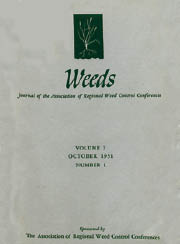Article contents
Response of Pensacola Bahiagrass to Herbicides
Published online by Cambridge University Press: 12 June 2017
Extract
Pensacola bahiagrass (Paspalum notatum F.) is a leading pasture grass in the Southeastern and Gulf Coast states where it produces high quality forage on relatively infertile soils low in available moisture. It is a major seed crop on which many farmers rely as a cash crop. Weeds compete strongly with this grass during its establishment and even after establishment of a sod, various annual or perennial weed species may encroach. Control of such weeds often is desirable.
- Type
- Research Article
- Information
- Copyright
- Copyright © 1960 Weed Science Society of America
References
Literature Cited
1.
Balgley, E.
HC-1281, or 2,3,6-Trichlorobenzoic acid. Proc. Calif. Weed Conf.
8:71–72. 1956.Google Scholar
2.
Hogard, T. W., and Hemphill, D. D.
White clover control in bluegrass turf. Res. Report NCWCC
13:128. 1956.Google Scholar
3.
Hogard, T. W., and Hemphill, D. D.
Spring control of checkweed in lawns. Res. Report NCWCC
13:129. 1956.Google Scholar
4.
Klingman, Dayton L.
Effects of herbicides on seedling and established grasses. Proc. NCWCC
6:72–73. 1949.Google Scholar
5.
Nutter, G. C., and Witherspoon, A.
Influence and effectiveness of growth retardants. Abstracts, WSA
1:48–49. 1956.Google Scholar
- 2
- Cited by


